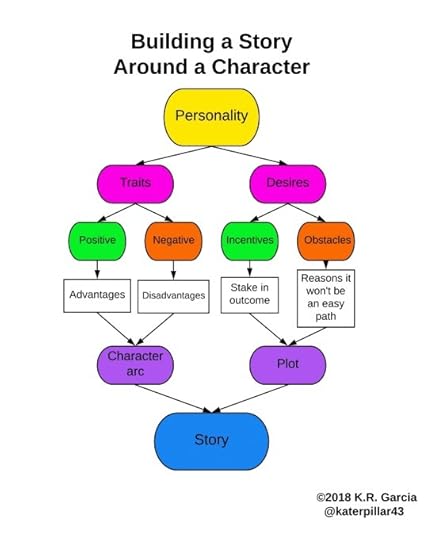How to Build a Story Around a Character (and Not the Other Way Around)

When you’re well into designing an enthralling plot, it’s easy to forget about what ultimately fuels the story: the characters! Today, writer K.R. Garcia shares her advice on how to develop realistic and resonant characters that will make any story shine:
Suddenly, it comes to you: a girl in a hot air balloon. The braids in her red hair have come free, and she’s standing at the edge of the basket, brandishing a vial of emerald liquid. The sky is peppered with milky white clouds, and the landscape below is a rocky wasteland of copper-grey.
You want to know who she is. But how can you build a story around just a fragment of an idea? Try building your story around a character!
As you might expect, it’s all about personality: the core of a character that drives their actions and, therefore, the plot. Personality branches into traits and desires.
Traits
What is your character like? They have positive and negative character traits—their advantages and disadvantages in the story. The conflict between these kinds of traits and their eventual resolution form the character arc.
I like starting out with five positive traits and four negative traits for a hero or vice versa for a villain. I’ve decided that the girl in the hot air balloon is a hero. Keeping in mind that traits are aspects of a character’s personality, not their physical features, professions, or skills, I can choose traits that fit the image I have of her. Let’s say her positive traits are adventurous, determined, clever, empathetic, and funny, and her negative traits are reckless, oversensitive, arrogant, and gullible.
Desires
What does your character want? For each of these desires, they should have an incentive and an obstacle in the way of them achieving that desire. These two things become, respectively, your character’s stake in the outcome of the story and the reasons it will not be easy for your character to get there.
One of your character’s desires will likely be stronger than the others, and this desire and its incentive and obstacle will come together to form the plot (the others can be subplots). If none of the desires stand out, that’s fine! Try looking at your list of desires. How can you connect them? What would happen if the worst outcome came out of an attempt to achieve one of those desires?
To start, I usually list ten desires for my characters. To find these, I can think about the events leading up to my idea fragment and imagine what could come next. For example, how did the girl in the balloon get there? I decide that she is trying to escape something. What is she escaping? I continue to ask questions and decide the answers until I have several desires to work with. I have to keep her character traits in mind so that none of her desires clash with them.

I’ll show you with my example:
Because she is empathetic, she desires to bring the cure for a disease home. She’s also clever, so she wants to escape the secret agents she stole it from. She’s adventurous, too, so she wants to control the hot air balloon.Beyond those desires, she has external incentives to succeed: her sister is sick, the agents mean her harm, and the hot air balloon is malfunctioning.
She still faces some obstacles: the cure will expire after three days, the secret agents won’t give up, and the hot air balloon is dropping towards the rocks below.
What’s the plot? My character goes on a quest to find a cure for her sister’s sickness, but the cure has to be used in three days, and the secret agents who created it will stop at nothing to find her.
This method works because characters are the lifeblood of the story. The plot is the mechanism that keeps the story going, but without any good characters to provide power, the mechanism couldn’t function. The character arc and plot come together to form the story.
By building the story around your characters, you can work your character seamlessly into the plot. Their stake in the outcome of the story will be strong and the threat of failure terrifying. But, most importantly, you’ll understand them better starting out. What better companion for a month of adventure than your own complex main character?

K.R. Garcia has been creating stories since before she could hold a pencil and has participated in nine NaNoWriMo and Camp NaNoWriMo events. An avid Agatha Christie reader, she writes mainly in the mystery and adventure genres. She coaches a class for young writers at her high school in Texas. When she is not writing, she enjoys classic rock, psychology, and music boxes. You can find her on Twitter at @katerpillar43.
Photo by Daniela Cuevas on Unsplash .
Chris Baty's Blog
- Chris Baty's profile
- 63 followers



